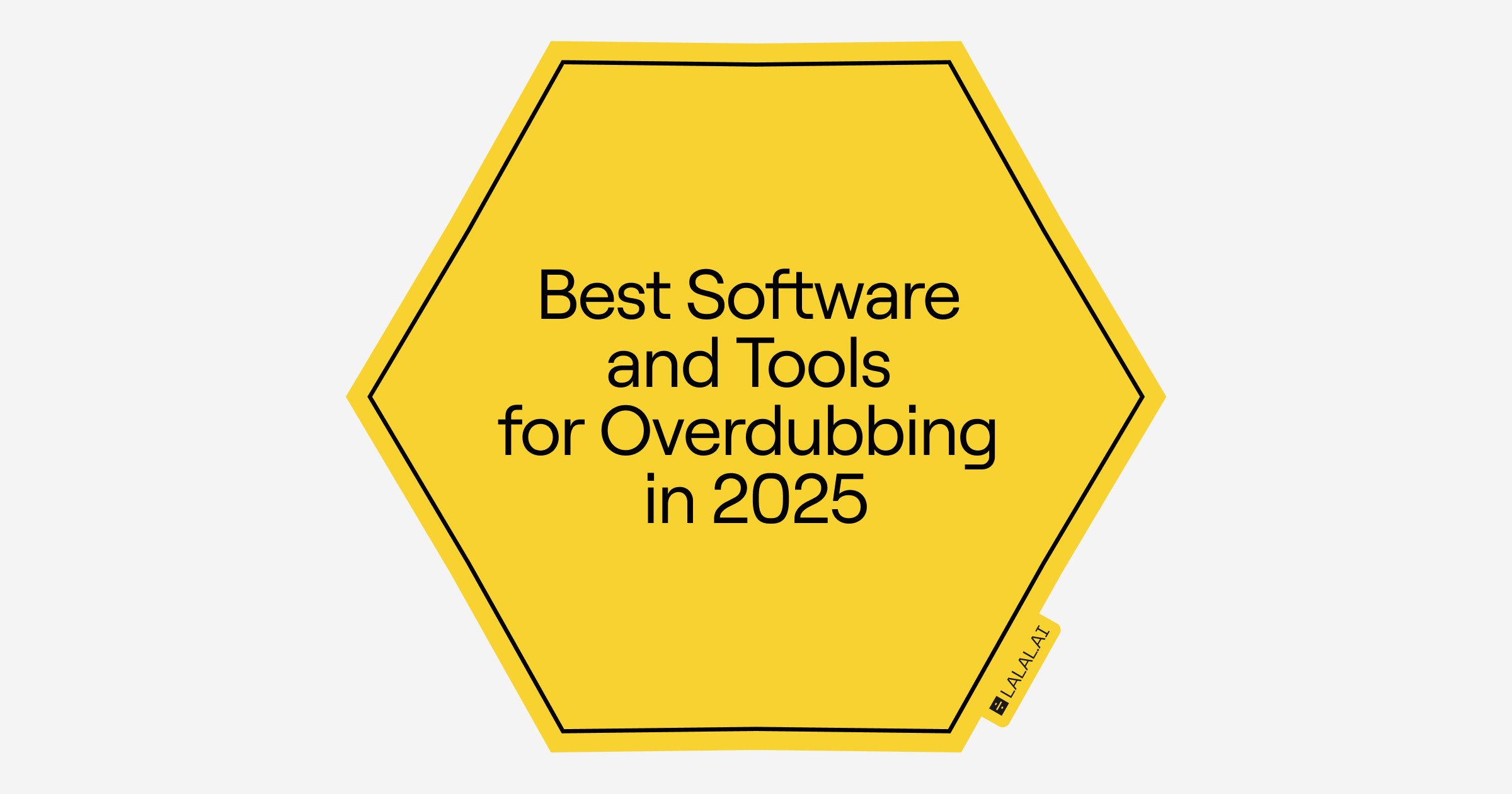Best Software and Tools for Overdubbing in 2025
Find the top software and practical tools for overdubbing in 2025. Voice cloning, audio editing, and fast fixes for music, podcasts, videos, audiobooks, and more.

If you’ve ever listened to an album where backing vocals suddenly appear out of nowhere, or enjoyed a podcast where a host drops in a story as if it’s being told live, you’ve heard overdubbing in action. Sometimes you barely notice it, and that’s when it’s really working.
In 2025, overdubbing isn’t reserved for music pros in glass-walled studios; it’s how YouTubers fix mistakes, how documentary teams bring old film to life, and how solo musicians record that one guitar part for the hundredth time until it sounds (finally!) right. Let’s have a practical look at the best tools for overdubbing this year with honest advice for people who care about making things sound right.
Why Overdubbing Matters (Even if You’re Not a Producer)
Maybe you’re a singer layering harmonies in your bedroom. Or a teacher recording e-learning modules and realizing you said “2024” instead of “2025”. Or maybe you’re a podcaster and your cohost recorded the track in a café with two toddlers yelping in the background. Overdubbing lets you fix, add, reshape, and smooth out your recordings without the heartache of starting from scratch.
I’ve had my own experiences with overdubbing and still remember the first time I used it. My band and I were in a friend’s makeshift studio, the kind with foam taped to the wall. I’d botched the chorus, everyone groaned, but instead of redoing the perfect verses, we just recorded the chorus again and patched it in. It was magic: suddenly, the whole thing felt a hundred times more professional.
Tools for this have come a long way. And while there’s always been a divide (pro tools, free tools, quick fixes), these days, and in 2025 in particular, there are real options for every level and price range.
DAWs, the Classic Workhorses
Digital Audio Workstations (DAWs) have been the central piece of audio work for decades. Overdubbing in these programs is mature, full-featured, and has a huge community for sharing advice and tricks.
Pro Tools
Despite all the newcomers, Pro Tools hasn’t lost its foothold in studios worldwide. Known for steady recording and detailed editing, it lets users record one or dozens of overdubs, all lined up neatly against the original. Features like Punch In let you slip in a phrase without recording a full new track, and its editing tools help keep sessions organized, so nothing important gets lost.
The version for students and smaller studios, Pro Tools Artist, still packs the needed basics: multitrack audio, detailed fades, and enough plugin compatibility to handle most mixing demands. This is the tool many professionals trust when every second and every decibel of sound quality counts.
Logic Pro
Over on the Mac side, Logic Pro remains at the top for users who like both composing and recording. If the project calls for overdubbing real musicians and then layering in software instruments, Logic switches easily between both.
Features are organized so that even without a team of engineers, users can stack harmonies, blend takes, and arrange them for larger productions. The Track Stacks tool helps organize overdubs so they don’t become a tangled mess. And transferring work from GarageBand to Logic makes the jump from first ideas to a polished result nearly effortless, though extremely complex projects may sometimes need manual adjustments during import.
Ableton Live, FL Studio, Reaper, Cubase
Ableton Live’s approach to working in “scenes” is favored by many who overdub performances in electronic music, theater, and even live event coverage. FL Studio’s visual loop system lets users stack vocals, percussion, or even whole song sections easily, making it a favorite among beatmakers and rappers. Reaper is admired for being affordable yet powerful, and Cubase has a long history supporting everything from film scores to game audio.
Using any of these DAWs, overdubs aren’t limited by technology; they’re more a question of how organized you want to be, and how detailed you prefer your editing.
Audacity
For those just starting out or working with a limited budget, Audacity remains one of the most accessible and reliable options. It’s a free, open-source audio editor available for Windows, Mac, and Linux. Recent versions have improved stability and offer useful features like multitrack editing, punch-in recording, and a simple interface that makes overdubbing straightforward.
While it doesn’t have some of the advanced tools found in paid software, Audacity provides all the basics needed to fix mistakes, layer tracks, and refine audio for podcasts, home recordings, and simple video projects. Its active user community also means plenty of tutorials and plugins are available to help users expand functionality as they grow.
AI-Powered Voice and Dubbing Software
A big leap in the last several years has come from AI tied directly into the recording workflow. It doesn’t mean computers do everything, but for patching, localizing, or creating voice material when the original speaker isn’t available, these tools save time and energy.
LALAL.AI
LALAL.AI Voice Cloner allows users to create a digital version of their own voice by uploading voice samples. Once the model is ready, it’s easy to generate new audio in your cloned voice for quick corrections or updates, no new recording session required. LALAL.AI Voice Changer goes a step further: it lets you apply your custom voice model to any audio track, so you can transform existing recordings or adapt different voices in your projects. It’s worth noting that Voice Cloner requires clear, sufficient voice samples; otherwise results may sometimes sound less natural than desired.
ElevenLabs and PlayHT
These platforms generate text-to-speech audio with a range of voices that can express emotion and variation better than many older TTS systems. ElevenLabs and PlayHT are often used for creating narrated explainer videos, subtitles with voice in different languages, or quick localization without hiring voice actors. Though many find the output impressively natural, subtle artificiality may be noticeable in careful listening or complex scripts.
Murf, Resemble, and Speechify
All provide AI voice synthesis with controls for pacing, tone, and emphasis. Murf, Resemble, and Speechify are increasingly used in education, product demos, accessibility, and internal communications. Users report that while quality is high for many cases, it varies across voices and languages. It’s best to think of these platforms as helpers rather than full replacements for professional voice actors.
Audio Repair and Matching Plugins
When overdubbing, new recordings need to blend naturally with original tracks. Differences in room acoustics, microphone types, background noises, or tonal balance can make an overdub stand out awkwardly.
iZotope RX and Ozone
iZotope RX specializes in repairing problem sounds: noise reduction, click removal, spectral repair, and ambience matching. For example, it can smooth out background hum or make the sound of a new vocal closer to the original environment. Ozone is better known as a mastering tool, helping to even out EQ and dynamics across an entire mix so overdubs don’t leap out unexpectedly. Both tools require some learning but are highly valuable in making overdubs sound consistent.
Mobile and Cloud-Based Overdubbing
Recording and fixing audio isn’t restricted to desktops anymore. Mobile apps and cloud platforms allow overdubbing anywhere.
GarageBand (iOS) and Splice
GarageBand keeps things straightforward on phones and tablets, making it possible to over-record vocals, try one idea after another, and add narration without a desktop computer. Many creators mix early drafts of podcasts or TikTok narrations here before using desktop tools for the final edit. Splice offers access to lots of samples, loops, and a quick multitrack workflow, all in the cloud, which means remote collaborations don’t get bogged down by slow file exchanges.
BandLab and Soundtrap
These cloud DAWs allow several people to add overdubs, rewrite sections, and mix in real time from different places. Teachers often use Soundtrap for class audio projects, while BandLab is favored for its simplicity among people launching YouTube channels or online music groups. The main benefit is flexibility: participants can record when it suits their schedule, with everything saved and organized centrally.
Tips for Smooth Overdubbing
Getting good overdubs takes more than software. Here are some practical pointers:
- Use clear track names to avoid confusion. For example, “Interview Fix, July 2025” speaks for itself, unlike “Audio_7.”
- Record multiple short takes and compile the best parts instead of settling for one long run.
- Group similar overdubs together, so harmonies, dialogue fixes, or sound effects are all on their own layers.
- Double-check for background noise changes between old and new takes; tools like RX help smooth these out if noticed early.
- Save backup copies at large milestones to avoid the risk of losing work or accidentally overwriting good takes.
Getting the right result isn’t only about the tools, but also how sessions are planned, so try your best to stay organized.
Follow LALAL.AI on Instagram, Facebook, Twitter, TikTok, Reddit, and YouTube for more information on all things audio, music, and AI.
